Intel Core i7-10700 vs Core i7-10700K Review: Is 65W Comet Lake an Option?
by Dr. Ian Cutress on January 21, 2021 10:30 AM EST- Posted in
- CPUs
- Intel
- Core i7
- Z490
- 10th Gen Core
- Comet Lake
- i7-10700K
- i7-10700
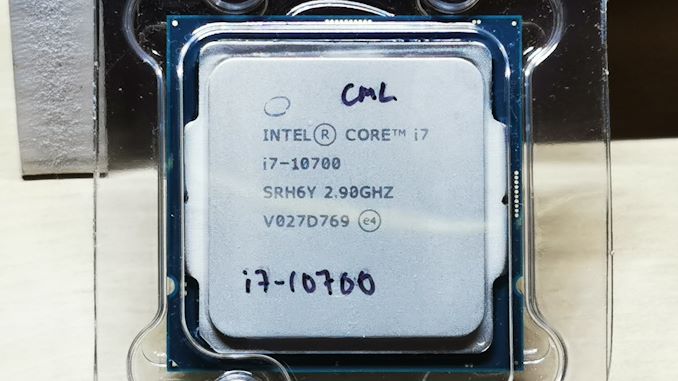
Over the years, Intel’s consumer processor lineup has featured its usual array of overclocking ‘K’ models, and more recently the ‘F’ series that come without integrated graphics. The bulk of the lineup however are still the versions without a suffix, the ‘nones’, like the Core i7-10700 in this review. These processors sit in the middle of the road, almost always having a 65 W TDP compared to the 91-125 W overclockable models, but also having integrated graphics, unlike the F family. What makes it interesting is when we pair one of these 65 W parts against its 125 W overclocking counterpart, and if the extra base and turbo frequency boost is actually worth the money in an era where motherboards don't seem to care about power?
Intel’s Core i7-10700 at 65 W: Is It Really 65 W?
The understanding of the way that Intel references its TDP (thermal design point) values has gone through a mini-revolution in the last few years. We have had an almost-decade of quad-core processors at around 90 W and 65 W, and most of them would never reached these numbers even under turbo modes - for example, the Core i5-6600K was rated at 91 W, but peak power draw was only 83 W. This has been the norm for a while, until recently when Intel had to start boosting the core count. As we have slowly gone up in core count, from 4 to 6 to 8 and now 10, these numbers have seemed almost arbitrary for a while.
The reason comes down to what TDP really is. In the past, we used to assume that it was the peak power consumption of the processor was its TDP rating – after all, a ‘thermal design point’ of a processor was almost worthless if you didn’t account for the peak power dissipation. What makes Intel’s situation different (or confusing, depending on how you want to call it) is that the company defines its TDP in the context of a 'base' frequency. The TDP will be the maximum power under a sustained workload for which the base frequency is the minimum frequency guarantee. Intel defines a sustained workload one in which the 'turbo budget' has expired, and the processor will achieve its best frequency above base frequency (but not turbo modes) .
The point about ‘not turbo’ is the key element here. Intel’s TDP ratings are only in effect for the base frequency, not the turbo frequency. If a PC is built with a maximum power dissipation in mind, allowing a processor to turbo above that power might have catastrophic consequences for the thermal performance of that system. The other angle is that Intel never quotes the turbo power levels (also known as Power Level 2, or PL2) alongside the other specifications, although they are technically in the specification documents when they get released.
On top of all this, motherboard manufacturers also get a say in how a processor performs. Because turbo power is only an optional suggestion from Intel, technically Intel will accept any value for the ceiling of the turbo power, and accept turbo under any circumstances if the motherboard manufacturer wants it. Motherboard manufacturers overengineer their motherboards to support longer turbo times (or overclocking), and so they will often ignore these Intel recommended values for PL2, allowing the processor to turbo harder for longer, and in a lot of cases of premium motherboards, indefinitely.
So why does all this matter with respect for this review? Well my key comparison in this review is our new processor, the Core i7-10700, up against its overclocking counterpart, the Core i7-10700K. Aside from the suffix difference, the K variant has a TDP almost twice as high, and this manifests almost entirely in the base frequency difference.
| Intel SKU vs SKU (an homage to Spy vs Spy) |
||
| Intel Core i7-10700K |
AnandTech | Intel Core i7-10700 |
| 8 C / 16 T | Cores / Threads | 8 C / 16 T |
| 3.8 GHz | Base Frequency | 2.9 GHz |
| 5.1 GHz | Peak Turbo (1-2C) | 4.8 GHz |
| 4.7 GHz | All-Core Turbo | 4.6 GHz |
| 2 x DDR4-2933 Up to 128 GB |
DRAM Support | 2 x DDR4-2933 Up to 128 GB |
| 125 W | TDP / PL1 | 65 W |
| Intel UHD 630 | Integrated Graphics | Intel UHD 630 |
| $374 | Price (1ku) | $323 |
Even though the TDP is 125 W vs 65 W, the peak turbo frequency difference is only +300 MHz, and the all-core turbo difference is only +100 MHz. In contrast, the base frequency difference is +900 MHz, and that is ultimately what the user is paying for. But this base frequency only matters if the motherboard bothers to put a cap on turbo budgets.
The base frequency is more of a minimum guaranteed frequency, than an absolute 'this is what you will get' value under a sustained workload. Intel likes to state that the base frequency is the guarantee, however if a processor can achieve a higher frequency while power limited, it will - if it can achieve that power value with 200 MHz above base frequency, it will run at the higher frequency. If this sounds familiar, this is how all AMD Ryzen processors work, however Intel only implements it when turbo is no longer available. This ends up being very processor dependent.
For the turbo, as mentioned, Intel has recommendations for power levels and turbo time in its documentation, however OEMs and motherboard manufacturers are free to routinely ignore it. This is no more obvious than when comparing these two processors. What does this mean for end-users? Well, graphs like this.

First time I saw these numbers, it shocked me. Why is this cheaper, and supposedly less powerful version of this silicon running at a higher turbo power in a standard off-the-shelf Intel Z490 motherboard?
Welcome to our review. There’s going to be a lot of discussion on the page where we talk about power, frequency, and the quality of the silicon. Also when it comes to benchmarking, because if we were to take an extreme view of everything, then benchmarking is pointless and I'm out of a job.
The Market
The Core i7-10700 and Core i7-10700K are both members of Intel’s 10th Generation ‘Comet Lake’ Core i7 family. This means they are based on Intel’s latest 14nm process variant (14+++, we think, Intel stopped telling us outright), but are essentially power and frequency optimized versions of Intel’s 6th Generation Skylake Core, except we get eight cores rather than four.
| Intel 10th Gen Comet Lake Core i9 and Core i7 |
||||||||||
| AnandTech | Cores | Base Freq |
TB2 2C |
TB2 nT |
TB3 2C |
TVB 2C |
TVB nT |
TDP (W) |
IGP | MSRP 1ku |
| Core i9 | ||||||||||
| i9-10900K | 10C/20T | 3.7 | 5.1 | 4.8 | 5.2 | 5.3 | 4.9 | 125 | 630 | $488 |
| i9-10900KF | 10C/20T | 3.7 | 5.1 | 4.8 | 5.2 | 5.3 | 4.9 | 125 | - | $472 |
| i9-10900 | 10C/20T | 2.8 | 5.0 | 4.5 | 5.1 | 5.2 | 4.6 | 65 | 630 | $439 |
| i9-10900F | 10C/20T | 2.8 | 5.0 | 4.5 | 5.1 | 5.2 | 4.6 | 65 | - | $422 |
| i9-10900T | 10C/20T | 1.9 | 4.5 | 3.7 | 4.6 | - | - | 35 | 630 | $439 |
| i9-10850K | 10C/20T | 3.6 | 5.0 | 4.7 | 5.1 | 5.2 | 4.8 | 125 | 630 | $453 |
| Core i7 | ||||||||||
| i7-10700K | 8C/16T | 3.8 | 5.0 | 4.7 | 5.1 | - | - | 125 | 630 | $374 |
| i7-10700KF | 8C/16T | 3.8 | 5.0 | 4.7 | 5.1 | - | - | 125 | - | $349 |
| i7-10700 | 8C/16T | 2.9 | 4.7 | 4.6 | 4.8 | - | - | 65 | 630 | $323 |
| i7-10700F | 8C/16T | 2.9 | 4.7 | 4.6 | 4.8 | - | - | 65 | - | $298 |
| i7-10700T | 8C/16T | 2.0 | 4.4 | 3.7 | 4.5 | - | - | 35 | 630 | $325 |
| T = Low Power F = No Integrated Graphics K = Overclockable TB2/TB3 = Intel Turbo Boost 2 (any core in CPU), TB3 (specific core in CPU) TVB = Thermal Velocity Boost (Spec = 70ºC); routinely ignored by motherboard vendors |
||||||||||
Both CPUs are rated to run dual channel memory at DDR4-2933 speeds, and have 16 PCIe 3.0 lanes with support for Intel 400-series chipsets. These are socket LGA1200 processors, and are incompatible with other LGA115x motherboards.
Aside from the power and frequency differences, the other one is the price: $335 MSRP for the Core i7-10700, and $387 MSRP for the Core i7-10700K. This is a +$52 difference, which is designed to enable better frequencies and overclocking on the K processor. The non-K processor may be shipped with Intel’s 65 W PCG-2015C thermal solution, depending on location, although the first thing you would want to do is to buy something/anything else to cool the processor with given that it'll peak at 215W in enthusiast systems.
On the competing side from AMD, the nearest solution is the Ryzen 5 5600X, a 65W version of Zen 3 with two fewer cores but higher IPC, with an MSRP of $300. This does come with a reasonably good default cooler. Our full review of the Ryzen 5 5600X can be found here.
This Review
The goal of this review was initially just to benchmark the Core i7-10700 and see where it fits into the market. As our testing results came into focus, it was clear that we had an interesting comparison on our hands against the Core i7-10700K, which we have also tested. In this review the focus will be on the difference between the two, focusing primarily on where the i7-10700 lands compared to the competition, and perhaps some of the complexities involved.
Test Setup
As per our processor testing policy, we take a premium category motherboard suitable for the socket, and equip the system with a suitable amount of memory running at the manufacturer's maximum supported frequency. This is also typically run at JEDEC subtimings where possible. It is noted that some users are not keen on this policy, stating that sometimes the maximum supported frequency is quite low, or faster memory is available at a similar price, or that the JEDEC speeds can be prohibitive for performance. While these comments make sense, ultimately very few users apply memory profiles (either XMP or other) as they require interaction with the BIOS, and most users will fall back on JEDEC supported speeds - this includes home users as well as industry who might want to shave off a cent or two from the cost or stay within the margins set by the manufacturer.
| Test Setup | |||||
| Intel LGA1200 | Core i9-10900K Core i9-10850K Core i7-10700K Core i7-10700 |
ASRock Z490 PG Velocita |
BIOS P1.50 |
TRUE Copper + SST* |
Corsair DomRGB 4x8 GB DDR4-2933 |
| AMD AM4 | Ryzen 9 5900X Ryzen 7 5800X Ryzen 5 5600X |
MSI MEG X570 Godlike |
1.B3 T13 |
Noctua NHU-12S SE-AM4 |
ADATA 2x32 GB DDR4-3200 |
| GPU | Sapphire RX 460 2GB (CPU Tests) NVIDIA RTX 2080 Ti FE (Gaming Tests) |
||||
| PSU | Corsair AX860i Corsair AX1200i Silverstone SST-ST1000-P |
||||
| SSD | Crucial MX500 2TB | ||||
| *TRUE Copper used with Silverstone SST-FHP141-VF 173 CFM fans. Nice and loud. | |||||
Many thanks to...
We must thank the following companies for kindly providing hardware for our multiple test beds. Some of this hardware is not in this test bed specifically, but is used in other testing.
| Hardware Providers for CPU and Motherboard Reviews | |||
| Sapphire RX 460 Nitro |
NVIDIA RTX 2080 Ti |
Crucial SSDs | Corsair PSUs |
 |
 |
 |
|
| G.Skill DDR4 | ADATA DDR4 | Silverstone Coolers |
Noctua Coolers |
 |
 |
 |
|
A big thanks to ADATA for the AD4U3200716G22-SGN modules for this review. They're currently the backbone of our AMD testing.
Users interested in the details of our current CPU benchmark suite can refer to our #CPUOverload article which covers the topics of benchmark automation as well as what our suite runs and why. We also benchmark much more data than is shown in a typical review, all of which you can see in our benchmark database. We call it ‘Bench’, and there’s also a link on the top of the website in case you need it for processor comparison in the future.
If anyone is wondering why I've written the SKU of the processor on it with a sharpie, as per our lead image, it's because when you're shuffling through a box of them in low light, what is printed on the headspreader can be difficult to read if the light isn't right. With a perminent marker, it makes it much easier to read at-a-glance.
Read on for our full review.


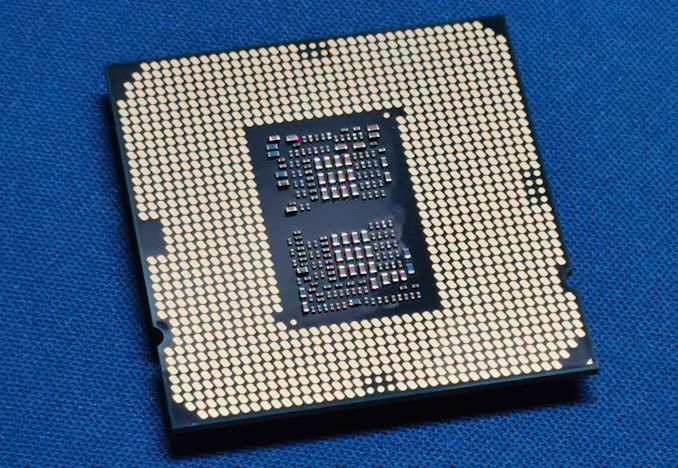
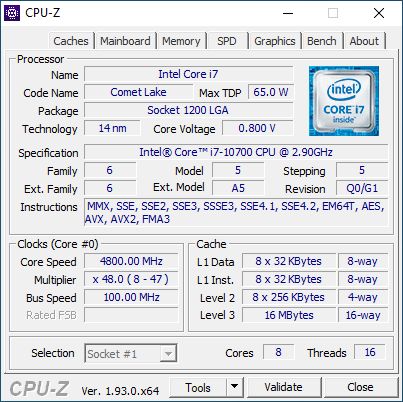
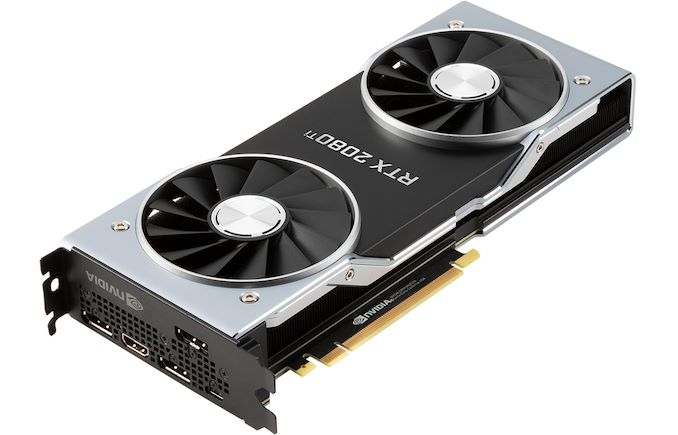
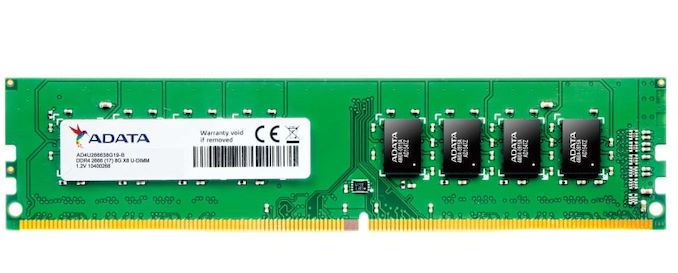








210 Comments
View All Comments
sjkpublic@gmail.com - Friday, January 22, 2021 - link
Yes. There is an issue with power consumption. And that is a lead into the real story. Intel has been at 14nm for 3 years now. Historically that time frame is unheard of. Some may say the complexity of the Intel CPU die is partly to blame. Some may say it is no wonder that Apple went to M1. Everyone will say Intel has dropped the ball.DieselPunk - Saturday, January 23, 2021 - link
Wow, here's a shock. Modern games get very little difference from CPUs as they are all GPU bound. And a good high end GPU is going to burn far more coal than a CPU ever will.As a gamer, WTF do I care about CPU power usage for? When I run out of coal there is still lots of gasoline 😎
headmaster - Saturday, January 23, 2021 - link
it's a great post admin thanks for ithttps://www.snapseedforpcguide.co/
yankeeDDL - Saturday, January 23, 2021 - link
Is it fair to say that the 10700 is on par (at best) or slower (in most multi-threaded scenarios) than the Ryzen 5600X, despite using roughly 2X the power?Makste - Saturday, January 23, 2021 - link
Put the number of cores into consideration as another factor, and then come up with your own conclusion.HarkPtooie - Sunday, January 24, 2021 - link
I registered just to post this: you're nuts.I just measured my "65W" i7-10700 non-K while stress testing it, and it eats 165 W at the wall plug. 64GB RAM, good quality Corsair 450W PSU.
Then I compared to to my "65W" Ryzen 3700X, 32GB RAM = 157 W. That one has an expensive fanless Seasonic 500W PSU which nominally better efficiency at these power draw levels.
So the difference is 10W and may as well be attributed to PSU quality, RAM consumption and whatnot.
If you are going to make wild speculations whose veracity anyone can check, you might want to go over your material a bit better.
Smell This - Sunday, January 24, 2021 - link
LOL
mmm ... Let me see.
Three feature writers at AT versus some 'anecdotal' FUD-peddling troll on the Internet. The Universe will make the call.
The 65w 8c/16t AMD Ryzen 3700X, fully loaded, pulls 90w. There is also a fancy multi-colored chart for you!
https://www.anandtech.com/show/14605/the-and-ryzen...
The i7-10700, in this article, pulls 197w to 214w. Ooops.
Psssst ___ By the way, my local MicroCenter (Duluth) offers the AMD Ryzen 3700X at $299 after $30 off, and the i7-10700 for $280 after $120 off. My-my-my, how the mighty has fallen . . .
HarkPtooie - Tuesday, January 26, 2021 - link
So you are saying that their wattmeters are right and mine is wrong because... appeal to authority?It may be that my Ryzen draws 90 W, but from the looks of it, the i7 is not far off. 10 more watts, not 130.
The universe will indeed make the call.
Spunjji - Wednesday, January 27, 2021 - link
Plausible explanations for the discrepancy, in order of likelihood:1) The unspecified stress test you're using isn't actually stressing the 10700 very heavily.
2) You're not measuring like-for-like in some other way - be it components or configuration.
3) Your wattmeter is poorly calibrated (This level would be a reach).
4) You're simply not being honest (I don't like to assume this, but you seem aggressive about people questioning your implausible conclusions).
Implausible explanations:
1) Every review on the internet performed with calibrated equipment, specified configurations and specified software loads is somehow wrong and you are right.
Everett F Sargent - Wednesday, January 27, 2021 - link
I'll go as far as requiring/requesting/asking for their MB model (an exact model number and manufacturer thereof). Without that one key piece of information, I have concluded the following: Using a Z490 or other relatively high end LGA 1200 MB indicates that the i7-10700 will run at or significantly above 200W in continuous 247 operation.Remember this user claims to be using a 450W PSU, so very likely not a Z490 MB, so indicative of a rather low end system (e. g. no medium to high end GPU, not that that matters as these are essentially CPU tests unless stated otherwise in this review).
I believe their power number but I don't believe that they are testing on a medium to high end LGA 1200 MB. In other words it is all about the MB default settings for PL1, PL2 and Tau and not the CPU itself.